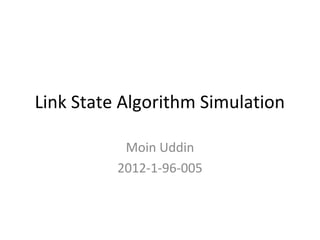Linkstate adv net_assignment
•Download as PPT, PDF•
0 likes•186 views
Report
Share
Report
Share

Recommended
More Related Content
Similar to Linkstate adv net_assignment
Similar to Linkstate adv net_assignment (20)
Routing and IP in Advance Computer Network,Vikram Snehi

Routing and IP in Advance Computer Network,Vikram Snehi
Et3003 sem2-1314-9 network layers vi (routing protocols)

Et3003 sem2-1314-9 network layers vi (routing protocols)
Recently uploaded
God is a creative God Gen 1:1. All that He created was “good”, could also be translated “beautiful”. God created man in His own image Gen 1:27. Maths helps us discover the beauty that God has created in His world and, in turn, create beautiful designs to serve and enrich the lives of others.
Explore beautiful and ugly buildings. Mathematics helps us create beautiful d...

Explore beautiful and ugly buildings. Mathematics helps us create beautiful d...christianmathematics
https://app.box.com/s/7hlvjxjalkrik7fb082xx3jk7xd7liz3TỔNG ÔN TẬP THI VÀO LỚP 10 MÔN TIẾNG ANH NĂM HỌC 2023 - 2024 CÓ ĐÁP ÁN (NGỮ Â...

TỔNG ÔN TẬP THI VÀO LỚP 10 MÔN TIẾNG ANH NĂM HỌC 2023 - 2024 CÓ ĐÁP ÁN (NGỮ Â...Nguyen Thanh Tu Collection
Recently uploaded (20)
This PowerPoint helps students to consider the concept of infinity.

This PowerPoint helps students to consider the concept of infinity.
Food Chain and Food Web (Ecosystem) EVS, B. Pharmacy 1st Year, Sem-II

Food Chain and Food Web (Ecosystem) EVS, B. Pharmacy 1st Year, Sem-II
Explore beautiful and ugly buildings. Mathematics helps us create beautiful d...

Explore beautiful and ugly buildings. Mathematics helps us create beautiful d...
Role Of Transgenic Animal In Target Validation-1.pptx

Role Of Transgenic Animal In Target Validation-1.pptx
ICT Role in 21st Century Education & its Challenges.pptx

ICT Role in 21st Century Education & its Challenges.pptx
ICT role in 21st century education and it's challenges.

ICT role in 21st century education and it's challenges.
Unit-IV; Professional Sales Representative (PSR).pptx

Unit-IV; Professional Sales Representative (PSR).pptx
TỔNG ÔN TẬP THI VÀO LỚP 10 MÔN TIẾNG ANH NĂM HỌC 2023 - 2024 CÓ ĐÁP ÁN (NGỮ Â...

TỔNG ÔN TẬP THI VÀO LỚP 10 MÔN TIẾNG ANH NĂM HỌC 2023 - 2024 CÓ ĐÁP ÁN (NGỮ Â...
Linkstate adv net_assignment
- 1. Link State Algorithm Simulation Moin Uddin 2012-1-96-005
- 2. Introduction • Link State is one of the two main classes of routing protocol • Link State Algorithm is characterized informally as each router “Telling the world about its neighbor.” • It’s a non-centralized way to discover the path. Each node stores distance or costs of the network by own. There is no centralized storing mechanism exists.
- 3. Link State Algorithm • First Rule, each router should know distance or cost between its neighbor. • Source must be a single node or router of the network. • Whole Process require steps equal to the number of routers or nodes exist in the network.
- 4. First Step • Source Node will be stored at U’. • Distances or costs of every neighbor of source will be stored as the least distance for this step. • For other nodes distance will be “~” or Infinity.
- 5. Next Steps • The node with least distance from source at the previous step will be stored in U’ array. • Distances of current U’ node’s neighbors from source through U’ will be discovered. • If new distances are less than previous, they will be updated as the latest least cost paths. • For other values will be remain same as before
- 6. Conclusion • Steps will be continued until costs through all nodes are discovered and compared. • Final result will be stored as the least cost paths.
